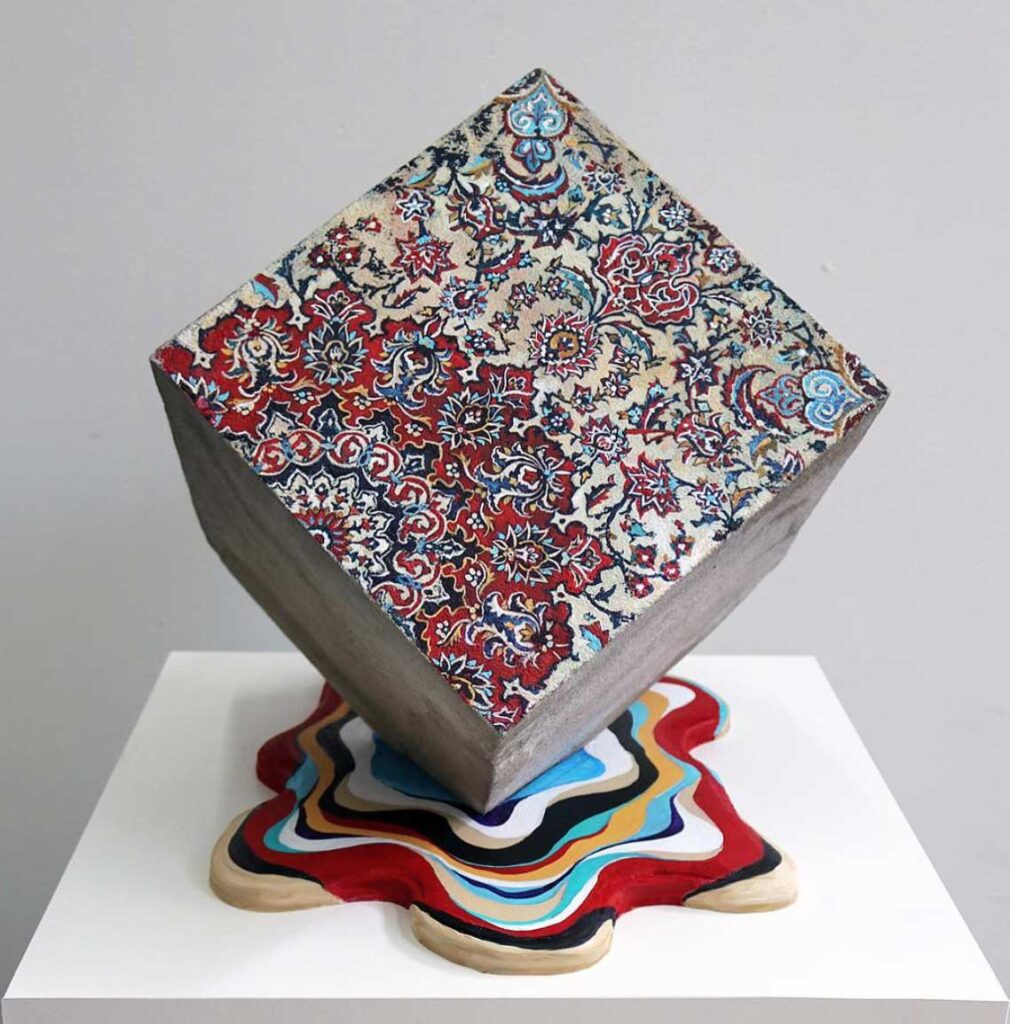AN EXCLUSIVE INTERVIEW WITH JASON SEIFE
BY JASMINE SUKARY
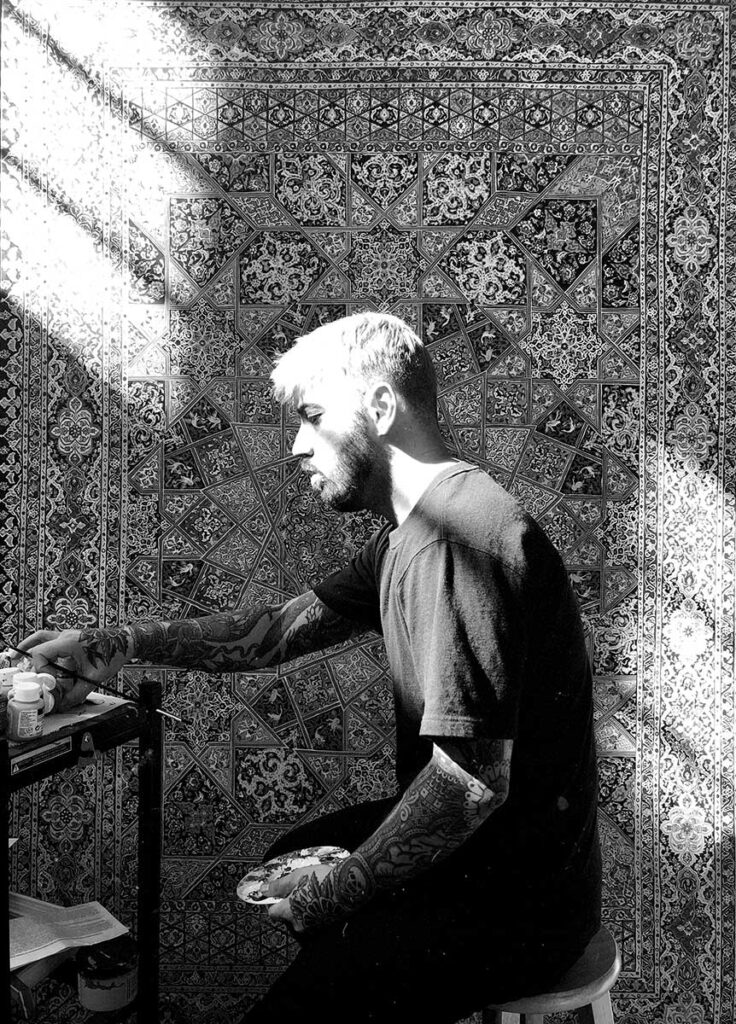

Artist Jason Seife, born in 1989 to immigrant parents of Middle Eastern descent, grew up surrounded by carpets, which played a significant role in his life. His unique rug paintings are created through a meticulous process involving making tiny brush strokes, allowing him to produce large-scale pieces as intricate as the original carpets and, in some cases, even larger.
Jason Seife’s work draws inspiration from old Persian carpets, an art form often overlooked in modern times. Carpets played a significant role in his childhood, and he is from a Middle Eastern background.
Jason meticulously recreates these traditional weavings by painting them on canvas, using colors and mediums not typically associated with their origins. He presents these pieces freshly and excitingly. The process of creating these artworks is both therapeutic and spiritual for him. His obsession with detail translates into the intricate geometry and compositions of the carpets, allowing him to work for hours without lifting his brush.
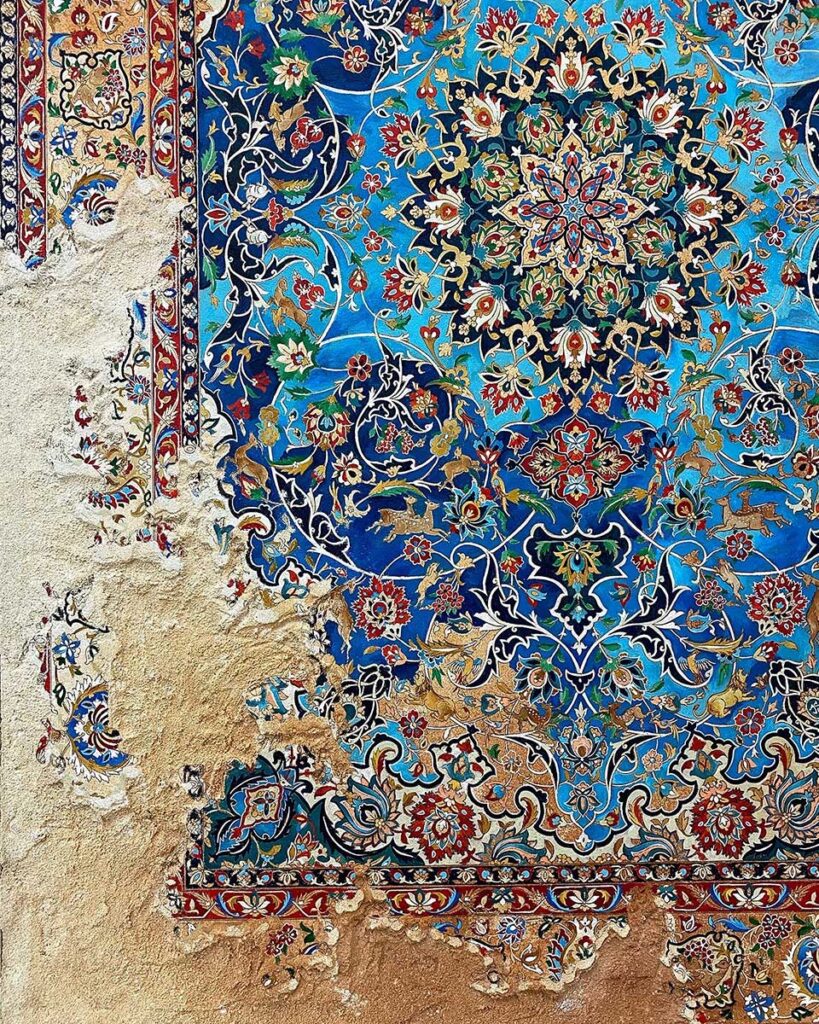
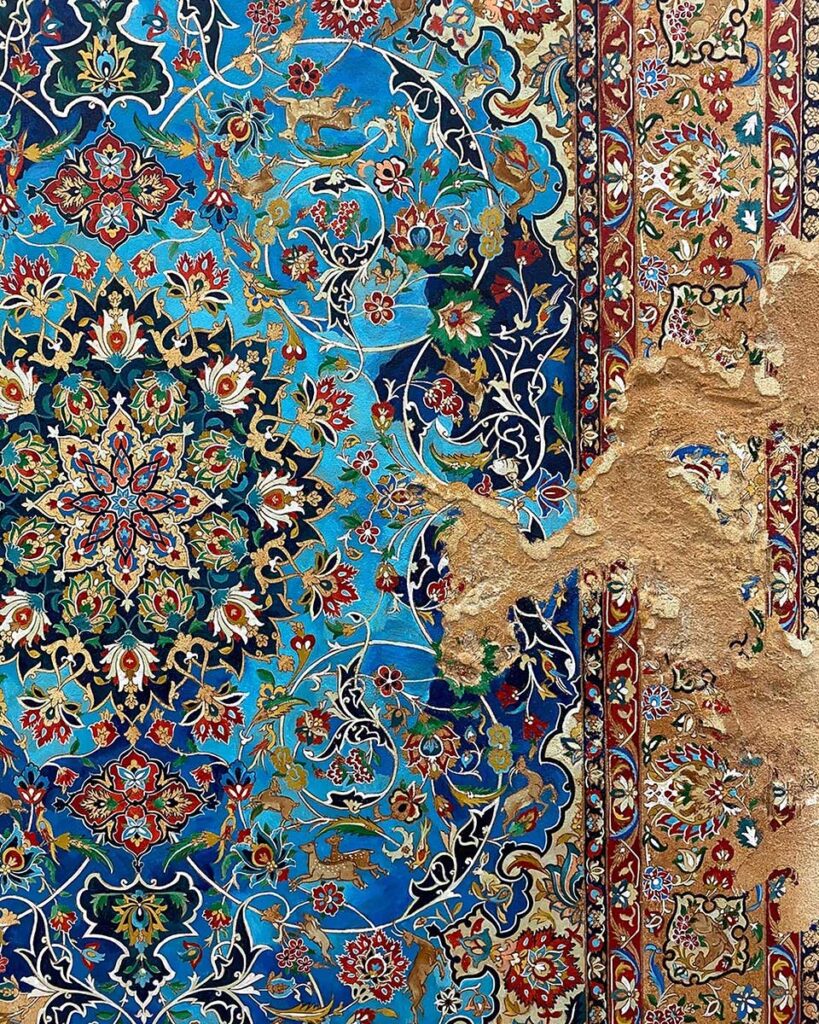
JASON SEIFE © All rights reserved.
What initially attracted him to these works was their aesthetic appeal and the rich history and meaning behind the imagery. Each rug’s unique pattern, color palette, and style can be linked to a specific geographic region or nomadic tribe that influenced its design.
Similarly, Jason aims to reflect this practice in his interpretation of carpets. He connects each color and pattern in his paintings to the particular state of mind and emotions he experienced during their creation. This approach enables him to look back and see a chronological timeline of his mental and emotional states embedded in the artwork, essentially creating a hidden language of shapes and colors that reveals itself upon closer examination.
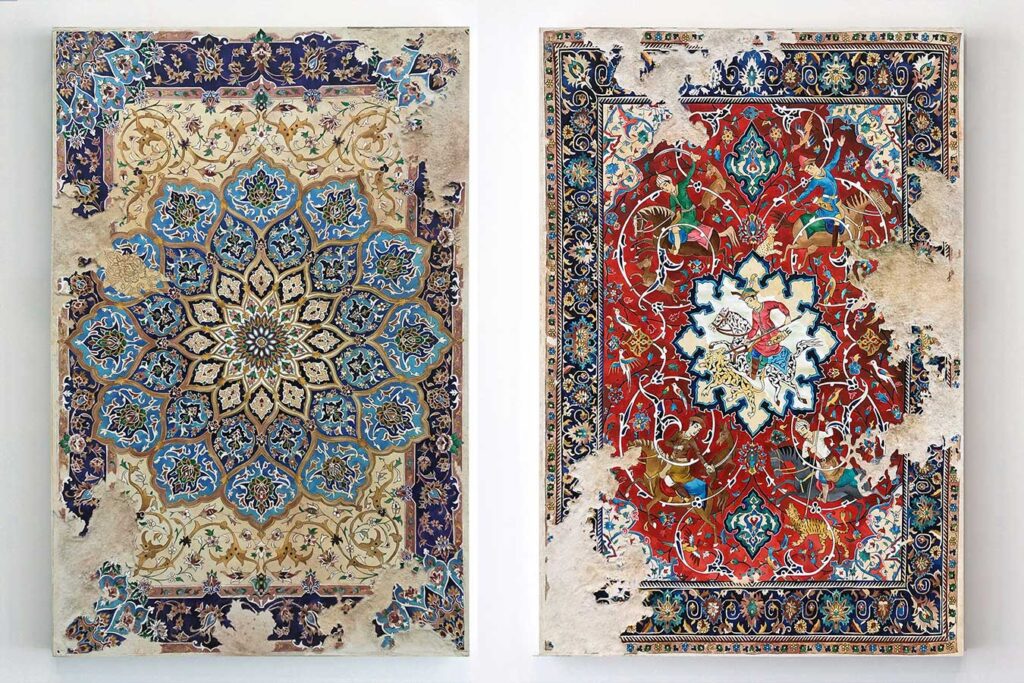
Right: “Leave it in my dream”. Acrylic on concrete. 60 x 40 inch. 2019.
JASON SEIFE © All rights reserved.
“I traveled to Iran and studied under carpet designers and weavers to understand how and why things are made the way they are. Once I had this basic knowledge and understanding, I was able to create my own styles and designs.”
AN EXCLUSIVE INTERVIEW WITH JASON SEIFE
BY JASMINE SUKARY
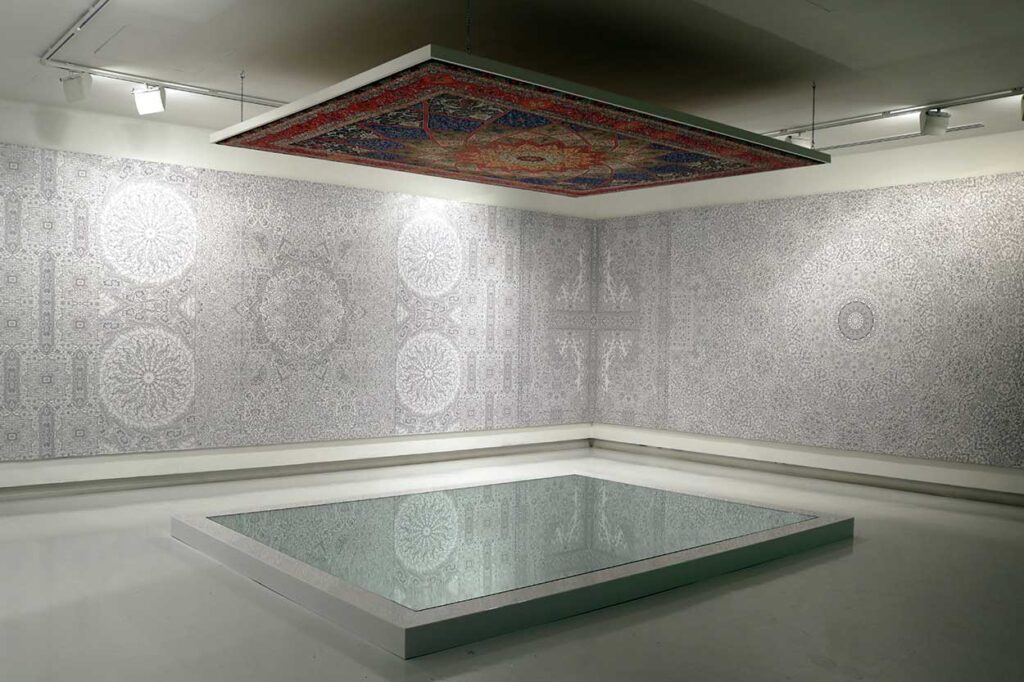
JASON SEIFE © All rights reserved.
Art Market Magazine: Thank you, Jason. It’s a pleasure having an interview with you. Your art is unique and impressive in so many aspects. It indicates a significant connection and attraction to Middle Eastern cultural roots. Tell us about your background, where you grew up, and where this attraction to art and oriental carpets came from.
Jason Seife: Thank you for having me and for the kind words!
I grew up in Miami with a mixed background. My parents are Syrian and Cuban. Being a first-generation American born to immigrant parents, it can be hard to fit in or to find where you belong. When you grow up in such mixed cultures, it becomes even more confusing.
I grew up with carpets in our homes. My parents are very artistic, and my household was always a creative place. For me, this artwork became an exploration of my roots and finding my purpose. I always needed to pick which side I gravitated towards or how to identify.
It wasn’t until I got older, started exploring my art, traveled to places like Syria and Iran, and followed my family’s journey to the US that I was able to create my own path. I realized I don’t have to choose anything; I can mix both and create my personal narrative.
While the artworks may seem very Arabesque in terms of patterns and design at first glance, I also draw a lot of inspiration from my Cuban side. I use colors and palettes that are typically found more in Caribbean art than Middle Eastern art.
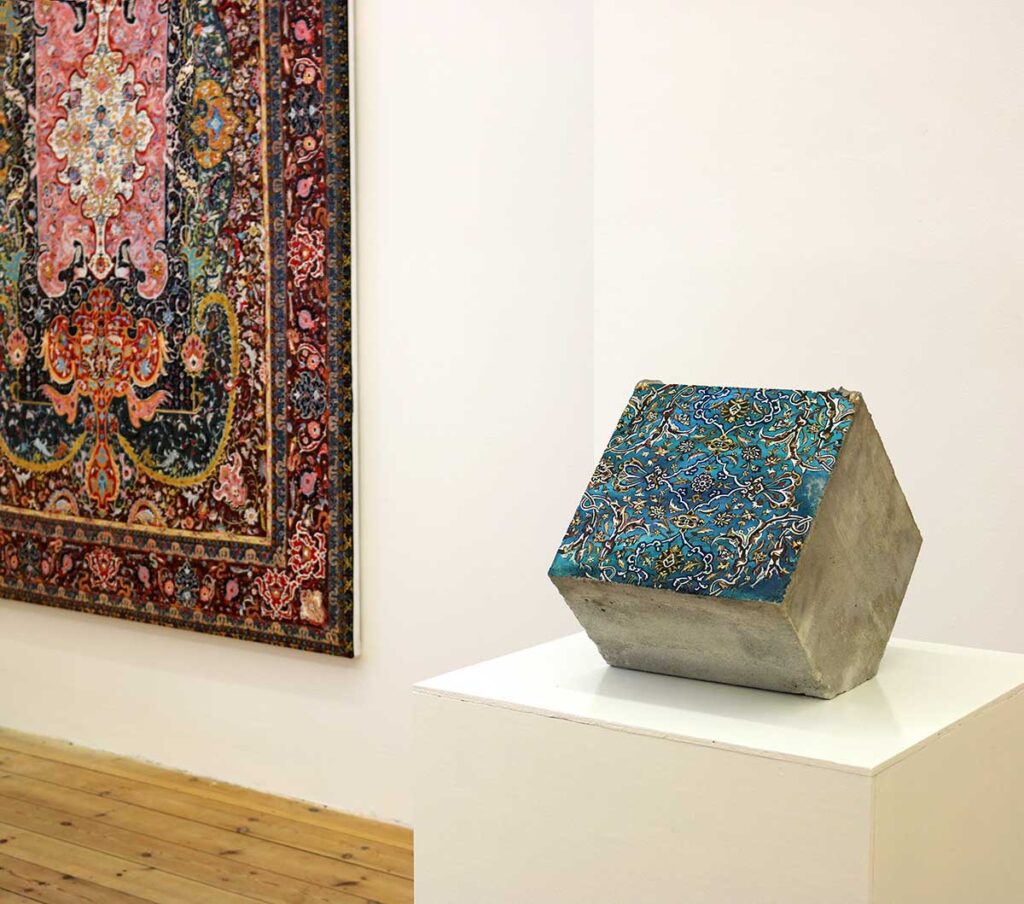
JASON SEIFE © All rights reserved.
“I moved a lot at a young age, sometimes the one piece that followed through different homes and stages of my life was a specific carpet that becomes a family heirloom. This can really signify a feeling of home, especially when you’re in a new and unfamiliar place.”

86 x 50 inch. 2018. Installation view. Solo Exhibition “Writing on the Walls”. Montoro 12. Brussels.
JASON SEIFE © All rights reserved.
A.M: Let’s talk about the oriental carpet artworks. For me, rugs symbolized the meaning of “Home.”
The elements’ technique and artistic structure pass through generations, connected to the community’s physical location and religion. What is carpets’ association with and meaning to you?
J. S.: I think you nailed the meaning and significance of “Home.” I moved a lot at a young age, and sometimes, the one piece that followed me through different homes and stages of my life was a specific carpet that became a family heirloom.
This signifies a feeling of home, especially in a new and unfamiliar place.
A.M.: Do you focus mainly on a specific style of oriental carpet? For example, are you focusing primarily on Persian Heriz, or can we find artwork focusing on Persian Gabbeh?
J. S.: I don’t focus on any specific style; I like to mix styles together. I don’t usually work from existing carpets, so I create my own patterns and styles. But for instance, at times, I will reference an Isfahan carpet for a center medallion and then maybe a Tabriz for the border, and so on, which then creates this sort of new breed of mixed styles.
When I began making this work, I was painting existing carpets—ones that we owned or that were dear to me—but then I started learning more about oriental rugs and their meaning.
I traveled to Iran and studied under carpet designers and weavers to understand how and why things are made the way they are. Once I had this basic knowledge and understanding, I was able to create my own styles and designs.
As mentioned before, I often reference existing designs but never create 1:1 copies. I usually take a few different elements, whether a motif or composition, that I like and then infuse them with my own designs to create something new.
A.M.: Can you please describe the workflow, from the stage of the image in your mind to the final result.
J. S.: My process is similar to the carpet design process. It starts with an idea, and then I sketch out a quarter of the design on paper (similar to carpet designing). I then redraw it digitally and mirror the 1/4th of the design to create the full work.
At this point, I either test colors digitally or begin the painting based on the digital outline. I then redraw it on canvas or whichever medium I’m working on, and then the actual painting part begins. It’s pretty extensive, and depending on the size and intricacy, it can take anywhere from 1 to 3 months per piece—sometimes even more.

“Writing on the Walls”. Montoro 12.
Brussels. 2018.
JASON SEIFE © All rights reserved.
A.M.: In your latest series of works, we can see the painting on the surface of a rock/ Acrylic on concrete, broken and scratched, which gives it a wonderful sense of an old piece of art from an archaeological location in the Middle East. Tell us about this series.
J. S.: I have been working with concrete and mortar mixtures for about 3 years. It has been a fantastic and exciting process to leave the comfort zones of canvas and explore new and usually unused mediums in terms of fine art. For me, this came from my travels in the middle east. Unlike in the West, it’s not common for buildings to be painted after they’re completed in the Middle East. Usually, the raw limestone or whichever stone is used is left exposed. With time, this has caused what I find to be a gorgeous natural abstraction.
These were incredibly inspiring, so I researched how these walls are made and directly referenced that in my practice of creating these substrates. It’s a mixture of limestone mortar and natural dyes.
I also distressed the material after I poured it and before it dried to create cracks and broken portions. Adding a second dynamic to the artwork is great instead of just being flat paintings. They become 3d and sculptural.
I also love the juxtaposition of what should be an aged effect, somehow making it seem a bit more modern and contemporary in its abstraction.
A.M.: You are very young (b. 1989) and have already exhibited in many locations around the world, represented by Unit London Gallery if I’m not mistaken. Your art has been featured in many articles and interviews, including at christiesrealestate.com for interior designers and architects. Looking back, did you expect this success?
J. S.: I fell in love with art at a very young age; after finding a book on Van Gogh in my aunt’s closet at the age of 9, I became obsessed with his work and the idea of painting. So, having started and dreamed of this from such a young age, it feels like it’s been quite a journey that has involved all sorts of ups and downs, but I’m still very fortunate to be able to do what I love for a living.
Growing up with immigrant parents, this career choice didn’t seem like a possibility to them, so I am entirely grateful for this opportunity. I can’t say I ever expected this success, nor do I think of myself as “successful. ” For me, it’s just about creating artwork that can inspire future generations, especially those who may feel this form of art is becoming obsolete. I think I’m on the right path as long as I can continue to do that.
See The Full Interview Article in Art Market Magazine Issue #100


